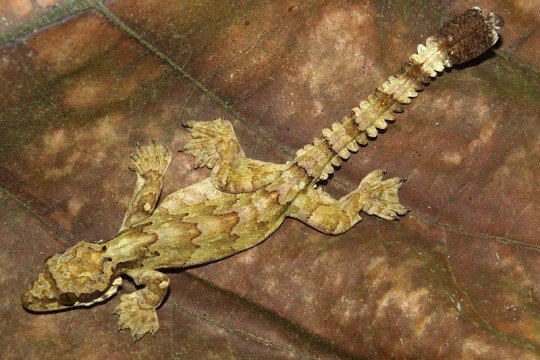#gekko kuhli
Photo

Kuhl’s flying gecko (Gekko kuhli) in Perak, Malaysia
by Bernard Dupont
#kuhl's flying gecko#geckos#lizards#reptiles#gekko kuhli#gekko#Gekkonidae#squamata#reptilia#chordata#wildlife: malaysia
163 notes
·
View notes
Text

Madagascar day gecko (Phelsuma madagascariensis) ; Kuhl's flying gecko (Gekko kuhli)
Reptiles and Amphibians of the World. Written by Hans Hvass. Illustrated by Wilhelm Eigener. Originally published in 1958.
Internet Archive
128 notes
·
View notes
Text

2 notes
·
View notes
Text
A Beautiful Flying Gecko
A Beautiful Flying Gecko

View On WordPress
0 notes
Text
Flying Gecko!
Flying Gecko!
There are a few different species of flying gecko but this particular one is Kuhl’s flying gecko (Gekko kuhli)
They have elongated skin flaps on the side of their body, between their toes and a flattened tail
These adaptations allow it to glide over short distances
The skin flaps along its body also help it blend in to trees to camouflage
If you have read this far why not follow us @animalfacthub for daily animal facts and pics!
-

📷1: “Ptychozoon kuhli (Kuala Lumpur).jpg” by Sundar on Wikimedia Commons (CC BY-SA 4.0)

📷2: “Ptychozoon kuhli underside.jpg” by Dawson on Wikimedia Commons (CC BY-SA 2.5.0)

📷3: “Ptychozoon kuhli dorsal view.jpg” by Sundar on Wikimedia Commons (CC BY-SA 4.0)
0 notes
Photo

BHL Book Feature: Gecko Toes!
Gecko toes have fascinated herpetologists, physicists, and engineers for a long time. If you’ve ever had the occasion to watch them, you know that they can scurry along walls and even suspend themselves from ceilings with such ease! Duméril and Bibron shared in this fascination with detailed black-and-white illustrations of gecko toes byJean-Gabriel Prêtre. Here’s a close up from our featured illustration of a Lined Flat-tailed Gecko (Uroplatus lineatus).

So what is it about gecko toes that make them so sticky? Geckos have tiny hairs called “setae” on their toes that rely on van der Waals forces to create suction. With a multitude of these hairs acting together on the nanoscale level, geckos can stick and unstick seamlessly! Researchers have been studying this ability for applications in adhesives, particularly in space and in robots.

Gecko toes vary widely in shape, size, and layout, which you can easily see in this plate which contains 8 different species. Here is the breakdown by figure.
FIGURE 1: Seychelles Bronze Gecko (Ailuronyx seychellensis)
FIGURE 2: Blue-tailed Day Gecko (Phelsuma cepediana)
FIGURE 3: White-spotted Wall Gecko (Tarentola annularis)
FIGURE 4: Tokay Gecko (Gekko gecko)
FIGURE 5: Kuhl's Flying Gecko (Ptychozoon kuhli)
FIGURE 6: New Caledonia Giant Gecko (Rhacodactylus leachianus).
FIGURE 7: Big Tree Gecko (Gehyra oceanica)
FIGURE 8: Dakota's Leaf-toed Gecko (Hemidactylus triedrus)
This week we are featuring André Marie Constant Duméril & Gabriel Bibron, Erpétologie Générale, Vol. 3 Atlas (1854), the first comprehensive scientific description of reptiles and amphibians. Learn more about this foundational work on our blog, and explore more SciArt from the 120 plates in our Flickr album. Thanks to @smithsonianlibraries for contributing this series for digitization!
#Erpétologie Générale#BHL Book Feature#BHLib#Smithsonian Libraries#gecko#geckos#lizards#herpetology#reptiles#gecko toes
89 notes
·
View notes
Text

Grzimek's Animal Life Encyclopedia. Volume 6: Reptiles. Written by Bernard Grzimek. 1984.
1.) Tokay gecko (Gekko gecko)
2.) Peacock day gecko (Phelsuma quadriocellata)
3.) Auckland green gecko (Naultinus elegans)
4.) Kuhl's flying gecko (Ptychozoon kuhli)
5.) Mediterranean house gecko (Hemidactylus turcicus)
6.) Common wall gecko (Tarentola mauritanica)
7.) Day gecko (Phelsuma madagascariensis)
8.) Common flat-tail gecko (Uroplatus fimbriatus)
#reptiles#lizards#geckos#tokay gecko#peacock day gecko#auckland green gecko#kuhl's flying gecko#mediterranean house gecko#common wall gecko#day geckos#common flat-tail gecko#signature
172 notes
·
View notes